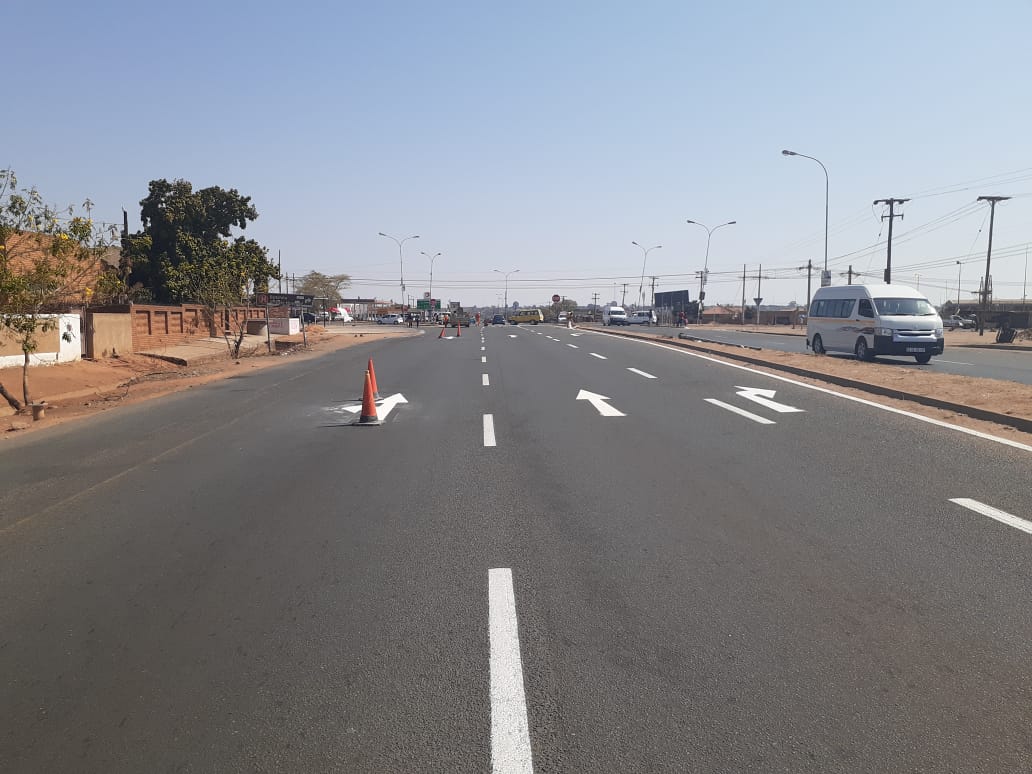We keep people
safe on the road
South Africa #1 in road marking
and maintenance
Get A Quote : 082 045 3054
S
Solvent
Based Road
Markings
W
Water
Based Road
Markings
T
Thermo
Plastic Road
Markings



We work on national and provisional and urban roads as well as
service the commercial industry, i.e. office parks, shopping malls, etc.
Neat Roads offer every option in road markings to suit the needs of the customer; Solvent Based Road Markings,
Water-Based Road Markings, Thermo Plastic Road Markings
GET A FREE QUOTE
Sorry, but you are a Spammer.
Road maintenance
One of the advantages of thermoplastic paint is its durability. As a result, it is virtually a maintenance-free option for road markings. However, it is more costly to use thermoplastic paint which is why the road marking industry tends to favor water-based marking paint.
Maintenance issues that need to be dealt with regardless of what paint is used range from dealing with reduced retroreflection as glass beads break down to stains and discoloration, patching, replacing, re-marking and removing markings.We are South Africa’s road marking Specialists.
Quality control
Our success is attributed to our business philosophy of “do what you know best”. Years of knowledge and experience combine to provide a road marking service that meets clients’ individual needs.
Neat Roads prides itself in having dedicated road marking teams that work to international standards in the local South African environment. In addition to marking roads and stenciling traffic instructions, it’s the role of Neat Roads to manage road safety, conformity, good traffic management and to do the best job the first time around.#1 in road markings in South Africa. From traffic signs, lines and arrows – we do everything in between.
What our clients say about us
Leading road marking and maintenance company in South Africa
Road marking and maintenance plays a vital role in reducing traffic congestion, accidents, and fatalities on South Africa’s roads. Neat Roads offers paint applications and road marking and maintenance services that match international standards; meeting clients’ individual needs without compromising durability and visibility.
Neat Roads is a leading road marking and maintenance company based in Tshwane. The company has earned itself a reputation for marking roads to the highest standards, meeting SABS-approved requirements. The company offers its services to the general public, corporate and government institutions; at a price that is excellent value for the quality of its products and services.
Road marking is more than a matter of painting lines. It requires a valuable skill set and knowledge to install a traffic regulating system to facilitate the flow of traffic and reduce traffic disruptions and congestion, and a thorough understanding of road marking paint and what is needed to guarantee uniformity, visibility, and durability depending on the environment and climate.
Read More
Maintaining high standards in road marking and maintenance
Road marking in South Africa is an important way of controlling traffic and ensuring the safety of thousands of commuters every day. It involves any kind of device or material that’s used on a road surface in order to convey official traffic or pedestrian information.
Road markings are used in conjunction with road signal lights and road signs to convey certain regulations, warnings and information that cannot otherwise be communicated to road users.
Typical road markings provide instructions for:
- separating traffic
- stop and go
- giving way
- overtaking allowed
- two lanes converging into one lane traffic
- recommended distance between vehicles
- parking or non-parking zones
- speed indication
- one-way or two-way traffic direction
- pedestrians crossing
- type of vehicles allowed
Why quality control is so important for road markings
Uniformity and standardisation of road markings are vital as both reduce confusion and uncertainty about their meaning. Impactful road markings keep the number of road accidents to a minimum which is why quality control is so important.
The highest percentage of road accidents occur at night. This is the main reason road markings need to be retroreflective to guide road users, although road accidents are not necessarily caused by poor or defective road markings. Road markings give road authorities a certain degree of control which ensures traffic flows smoothly, accidents are prevented and traffic safety is a priority.
Maintaining high standards with the latest in road marking technology is one way Neat Roads can contribute to keeping people using our highways and roads safe.
Durability and visibility for road safety
Visibility is key to road markings. How impactful and effective road markings are is evaluated on night-time visibility (retro-reflectivity) and day-time visibility (luminance) as well as colour and skid resistance. This applies to pavement markings, white line and yellow line markings and car park line markings.
In South Africa, there are SABS standards on solvent-borne and waterborne road-marking paints covering a wide range of aspects. However, there are insufficient standards on plastic road-marking materials and road marking applicators. Neat Roads apply their own high standards by only using the highest quality materials and applicators.
Composition of road markings
There are various types of road-marking materials available which vary in price and performance. This include;
• the paint itself
• retroreflective beads
• the road or pavement surface
To determine paint performance; the durability, visibility and drying time of the paint are the deciding factors. Drying time is an important factor where faster drying paint reduces the amount of time traffic is disrupted and avoids a poor quality finish where vehicles have crossed over and smudged wet paint.
Types of road marking paints
Quality road marking paint is alkyd based, quick drying and has a matt finish. Quick drying paint is ideal for tar, concreate and asphalt surfaces which require a barrier coat of paint, paint that doesn’t bleed and a paint that doesn’t discolour.
Commonly used road marking paints include:
Solvent-based paint
Solvent-based road surface paint is manufactured using a modified styrene acrylic polymer to produce a quick drying and highly durable road marking paint that does not bleed on most bituminous surfaces. It’s a more economical choice and used extensively in the road marking industry.
Water-based paint
Water-based paint also comprises a modified styrene acrylic polymer to produce a quick drying and highly durable road marking paint that does not bleed on most bituminous surfaces. Being water-based, the main difference is this paint produces little to no smell, compared to the traditional oil-based road marking paints. This makes it safer to use and is more environmentally-friendly than solvent-based paint.
Thermoplastic paint
Also called hot melt marking paint, thermoplastic road marking paint is a kind of powder paint. When applied to a road surface, a hot melt kettle heats it up to 200°C before it is sprayed on the road surface. It’s fast drying and produces a thick coated, wear-resistant, bright and reflective road marking. It has added reflective glass beads and is the best road surface paint for anti-skid.
The purpose of glass beads
All road marking paint has glass beads in its composition which improves visibility in the daytime and night-time. Without glass beads, most of the natural sunlight and a car’s headlights would reflect away from the driver. Glass beads cause light to reflect back to the driver which increases visibility.
Night-time visibility (retroreflection) (RL) is when the headlights of the vehicle illuminate road markings and the glass beads return the light to the eyes of the driver, allowing him or her to use the markings as guidance.
Day-time visibility (luminance) (Qd) is when the sunlight illuminates the road markings and the glass beads reflect light in all directions including in the direction of the eyes of the driver.
We know that retroreflective performance of pavement markings is mainly provided using glass beads. However, there are other factors that contribute to the performance of retroreflective paint. These include the composition of the binder material, such as colour, pigment type and amount, thickness, characteristics of the glass beads, pavement surface roughness and the amount of rubble and dirt on the road marking.
Equipment used for road marking
Neat Roads uses quality equipment to improve the quality of finish and durability of road markings. This includes all machinery and a range of marking stencils used to produce neat road markings that are above the industry standard.
Machinery, equipment and tools used to create road markings largely depend on the size of the community, kilometres of roadway, geographic characteristics, pavement surfaces, road marking budget and the type of marking required.
Equipment used by Neat Roads falls into two broad categories:
• small, self-propelled or manually-controlled low capacity paint market which is used for marking symbols, turning markets, pedestrian crossing markers and other transverse markings and legends
• heavy-duty, self-contained or auxiliary multi-lane truck-mounted units which are used typically for longitudinal road markings
Parking lot stencils are an economical way to provide safety instructions. Neat Roads uses road marking stencils to demarcate parking spaces or communicate traffic instructions. These quality road marking stencils allow Neat Roads to produce stencilled markings that are applied easily and quickly, and produce neat, detailed markings that do not bleed on must bituminous surfaces.
What are longitudinal line markings?
These white lane markings are placed on the roadway surface in the direction of the traffic to indicate to a driver in which direction the traffic is flowing. They also serve a purpose of indicating to the driver when he/she can safely pass a vehicle. Bold, unbroken longitudinal lines indicate it is unsafe to pass a vehicle, and a dotted longitudinal line indicates the driver may pass with caution.
Neat Roads uses specialised equipment for longitudinal road marking which prepares the road surface and applies quick-drying road marking paint which contains glass beads for improved visibility.
What are transverse line markings?
These lines are typically your stop and yield line markings that inform drivers whether they must stop or yield at an intersection. Drivers yield for on-coming traffic or pedestrians where it is not necessary to come to a full stop. Transverse line markings also indicate where a driver may merge safely into oncoming traffic at intersections.
Neat roads and safety first
Road marking carried out by Neat Roads places driver and pedestrian safety as a priority. Our teams of markers work to the highest standards to redirect pedestrian and traffic in a safe manner, limit traffic disruptions as far as possible and produce a quality result with a promise of high visibility and long-lasting durability.




